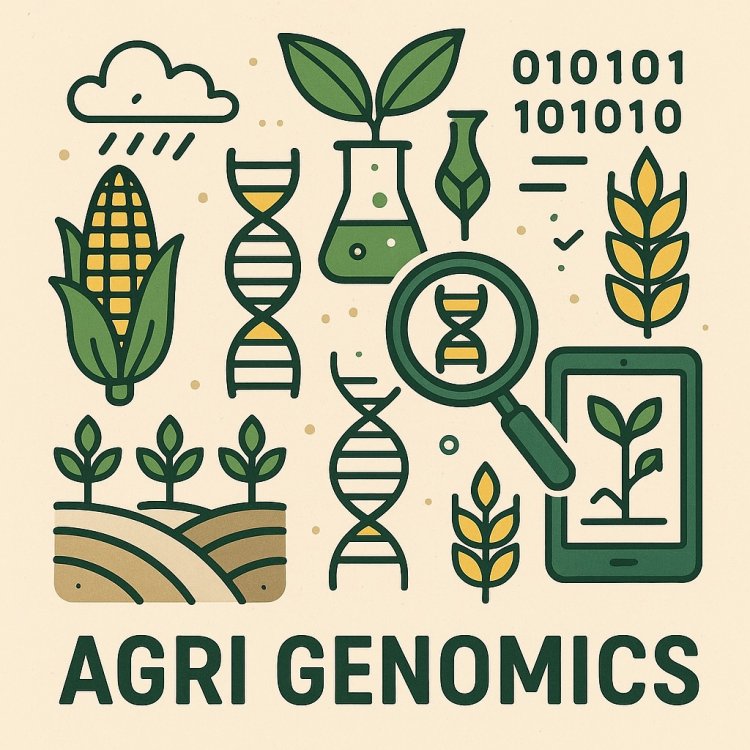Growth Potential of Agri Genomics Market Expected to Reach USD 6.7 Billion by 2030
Explore the Agri Genomics market with insights on market size, growth drivers, challenges, regional trends, key players, and future opportunities. Discover how genomics is transforming agriculture for a sustainable future.

Key Takeaways
- The global Agri Genomics market is projected to grow from USD 3.4 billion in 2022 to USD 6.7 billion by 2030, at a CAGR of 10.3%.
- Agri Genomics involves the application of genomics in agriculture to improve crop and livestock productivity, disease resistance, and sustainability.
- Market growth is driven by technological advancements, food security concerns, and the need for sustainable agricultural practices.
- Challenges include high costs, regulatory hurdles, and public skepticism about genetically modified organisms (GMOs).
- North America leads the market, while Asia Pacific and Europe are emerging as significant growth regions.
- Key players are leveraging partnerships, innovation, and advanced technologies to maintain competitiveness.
- Future trends include the rise of precision agriculture, advanced sequencing, and the integration of AI and big data.
Agrigenomics Market Overview
Agri Genomics, a rapidly evolving field at the intersection of agriculture and genomics, is transforming the way we approach food production, crop improvement, and livestock management. At its core, Agri Genomics refers to the application of genomic technologies and methodologies to agricultural research and practice. This includes the sequencing, analysis, and manipulation of the genetic material of plants, animals, and microorganisms to enhance desirable traits such as yield, disease resistance, drought tolerance, and nutritional value. The scope of Agri Genomics is vast, encompassing everything from marker-assisted selection and genome editing to the development of genetically modified organisms (GMOs) and the study of soil microbiomes.
According to analysts at Vantage Market Research, the Global Agri Genomics Market was valued at USD 3.4 billion in 2022 and is expected to reach USD 6.7 billion by 2030, growing at a robust CAGR of 10.3% between 2023 and 2030. This impressive growth trajectory is a testament to the increasing adoption of genomic tools in agriculture, driven by the need to address global challenges such as food security, climate change, and resource scarcity. Key applications of Agri Genomics include crop and livestock breeding, disease diagnostics, trait mapping, and the development of biofortified foods. By enabling precise and efficient selection of traits, Agri Genomics is helping farmers and researchers develop crops and animals that are better suited to the demands of a changing world.
The market’s expansion is also fueled by the growing demand for high-quality, sustainable, and traceable food products. Consumers are increasingly interested in the origins and safety of their food, prompting producers to adopt genomic technologies for quality assurance and traceability. Additionally, governments and international organizations are investing in Agri Genomics research to support food security initiatives and promote sustainable agricultural practices. As a result, the Agri Genomics market is poised for continued growth, with significant opportunities for innovation and collaboration across the value chain.
Driving Factors of Agrigenomics Growth
The growth of the Agri Genomics market is underpinned by several key driving factors, chief among them being advancements in genomic technologies. Over the past decade, the cost and speed of DNA sequencing have improved dramatically, making it feasible for researchers and producers to analyze the genetic makeup of crops and livestock at an unprecedented scale. Technologies such as next-generation sequencing (NGS), CRISPR-based genome editing, and high-throughput genotyping have revolutionized the field, enabling the identification and manipulation of genes associated with important agricultural traits. These innovations have accelerated the development of new crop varieties and livestock breeds that are more productive, resilient, and sustainable.
Rising concerns about food security are another major driver of Agri Genomics adoption. With the global population expected to reach nearly 10 billion by 2050, the pressure on agricultural systems to produce more food with fewer resources is intensifying. Genomic tools offer a powerful means of increasing crop yields, improving resistance to pests and diseases, and enhancing the nutritional content of food. By enabling the rapid development of improved varieties, Agri Genomics is helping to ensure a stable and secure food supply in the face of climate change, land degradation, and other challenges.
The importance of sustainable agricultural practices is also fueling the growth of Agri Genomics. As concerns about environmental degradation and resource depletion mount, there is a growing emphasis on developing crops and livestock that require fewer inputs, such as water, fertilizers, and pesticides. Genomic technologies enable the identification of traits associated with resource-use efficiency, allowing breeders to develop varieties that are better adapted to local conditions and less reliant on chemical inputs. This not only benefits the environment but also reduces production costs and enhances the resilience of farming systems.
Market Challenges and Restraints
Despite its many advantages, the Agri Genomics market faces several significant challenges and restraints. One of the most prominent barriers is the high cost of genomic analysis. While the price of DNA sequencing has decreased over time, the costs associated with sample preparation, data analysis, and interpretation remain substantial, particularly for small and medium-sized enterprises (SMEs) and resource-limited regions. This can limit the accessibility and adoption of genomic technologies, especially in developing countries where agricultural productivity gains are most needed.
Regulatory and ethical dynamics also pose challenges to the growth of the Agri Genomics market. The development and commercialization of genetically modified crops and animals are subject to stringent regulatory frameworks in many countries, which can slow down innovation and increase the time and cost required to bring new products to market. Additionally, there are ongoing debates about the ethical implications of genome editing and the potential risks associated with the release of genetically modified organisms into the environment. These concerns have led to calls for greater transparency, public engagement, and the development of robust regulatory frameworks to ensure the safe and responsible use of genomic technologies in agriculture.
Public perception of genetically modified products is another important restraint. Despite the scientific consensus on the safety and benefits of GMOs, there remains significant skepticism and opposition among consumers in many regions. This can create market barriers for producers and limit the adoption of genomic innovations. Addressing these concerns requires effective communication, education, and engagement with stakeholders across the food system, as well as the development of products that align with consumer values and preferences.
Regional Market Insights
The Agri Genomics market exhibits significant regional variation, with North America currently dominating the global landscape. The United States, in particular, is a leader in the adoption of genomic technologies in agriculture, thanks to its robust research infrastructure, supportive regulatory environment, and strong investment in innovation. Major universities, research institutes, and private companies in the region are at the forefront of developing and commercializing new genomic tools and applications. The presence of leading agribusinesses and biotechnology firms further strengthens North America’s position as a global hub for Agri Genomics.
Asia Pacific is emerging as a key growth region for the Agri Genomics market, driven by rapid population growth, increasing food demand, and government initiatives to modernize agriculture. Countries such as China, India, and Australia are investing heavily in genomic research and infrastructure, with a focus on improving crop yields, enhancing food security, and promoting sustainable farming practices. The region’s diverse agro-ecological zones and large agricultural workforce present significant opportunities for the application of genomic technologies to address local challenges and improve productivity.
Europe is also a significant player in the Agri Genomics market, characterized by a strong emphasis on sustainability, food safety, and regulatory compliance. The European Union has implemented comprehensive policies to support agricultural innovation while ensuring the safety and traceability of food products. Research collaborations between public and private sectors are driving the development of new genomic applications, particularly in the areas of crop improvement, disease resistance, and environmental sustainability. However, the region’s cautious approach to GMOs and genome editing may influence the pace of market growth.
Key Players in the Agrigenomics Sector
The Agri Genomics sector is characterized by a dynamic and competitive landscape, with several leading companies driving innovation and market growth. Major players include Illumina, Thermo Fisher Scientific, Eurofins Scientific, Agilent Technologies, and LGC Limited, among others. These companies are investing heavily in research and development to expand their product portfolios, improve the accuracy and efficiency of genomic analysis, and develop new applications for agriculture. Strategic partnerships, mergers, and acquisitions are common strategies used to enhance market presence and access new technologies.
Public-private partnerships play a crucial role in advancing Agri Genomics research and commercialization. Governments, research institutions, and industry stakeholders are collaborating to develop and implement genomic solutions that address pressing agricultural challenges. These partnerships facilitate knowledge sharing, resource pooling, and the translation of research findings into practical applications. For example, initiatives such as the International Wheat Genome Sequencing Consortium and the African Orphan Crops Consortium are bringing together diverse stakeholders to accelerate the development of improved crop varieties.
Innovation and collaboration are at the heart of the Agri Genomics sector. Companies are leveraging cutting-edge technologies such as CRISPR-based genome editing, high-throughput sequencing, and bioinformatics to develop novel solutions for crop and livestock improvement. Collaborations with academic institutions and research organizations enable access to new discoveries and expertise, while partnerships with farmers and agribusinesses ensure that genomic innovations are tailored to real-world needs and challenges.
Future Trends and Opportunities
Looking ahead, the future of Agri Genomics is shaped by several transformative trends and opportunities. The rise of precision agriculture is one of the most significant developments, enabling farmers to use genomic data to make informed decisions about crop management, input application, and breeding strategies. By integrating genomic information with data from sensors, drones, and satellite imagery, precision agriculture allows for the optimization of resource use, reduction of environmental impact, and enhancement of productivity.
The emergence of advanced sequencing technologies is another key trend, making it possible to analyze entire genomes quickly and cost-effectively. Third-generation sequencing platforms, such as those developed by Oxford Nanopore and Pacific Biosciences, are enabling real-time, in-field genomic analysis, opening up new possibilities for disease diagnostics, trait selection, and biodiversity monitoring. These technologies are also facilitating the study of complex traits and interactions within agricultural ecosystems, paving the way for more holistic and sustainable approaches to food production.
The integration of artificial intelligence (AI) and big data analytics is revolutionizing the Agri Genomics landscape. AI-powered tools can analyze vast amounts of genomic and phenotypic data to identify patterns, predict outcomes, and guide breeding decisions. Big data platforms enable the aggregation and sharing of information across the agricultural value chain, fostering collaboration and innovation. As these technologies continue to evolve, they will unlock new opportunities for improving crop and livestock performance, enhancing food security, and promoting sustainable agriculture.
FAQs
- What factors are driving the growth of the Agri Genomics Market?
- How is the Agri Genomics Market expected to evolve between 2023 and 2030?
- What are the key applications of agri genomics in agriculture?
- How does the current market value of the Agri Genomics Market compare to projections for 2030?


















